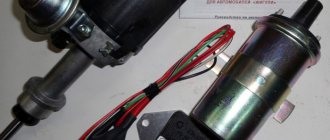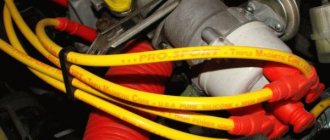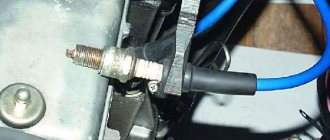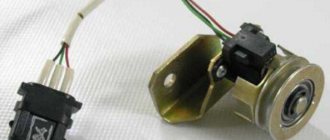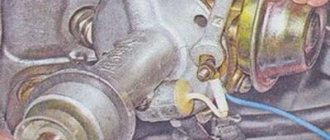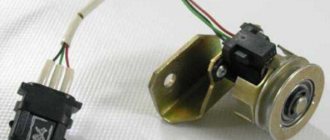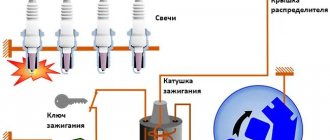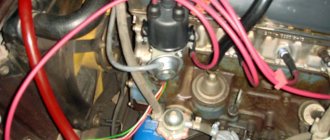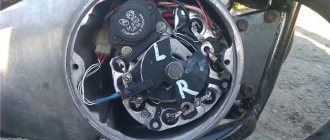A situation in which the engine does not start the first time, or does not start at all, can hardly be called pleasant. Experienced motorists know that any malfunction of the ignition system leads to partial and often even complete failure of the car engine.
So, if your car does not start the reasons:
• no current signals are supplied to the ignition coil; • fuel does not reach the carburetor; • current from the ignition coil does not enter the distributor; • reason there is no spark from the ignition coil; • no spark passes between the electrodes of the spark plug; • fuel liquid does not enter the combustion chamber; • the ignition distributor is broken.
The engine may also be blocked by the starter. But before checking the starter, inspect the condition of the electric motor winding; if it is not damaged, then the starter is most likely in good condition. Pay attention to the ignition coil.
The ignition coil is the converter of low voltage current to high voltage current in a vehicle's ignition system.
Malfunctions of the ignition coil are expressed by the following actions of the car:
• reduction in engine operating intensity; • problems starting the engine; • a sharp decrease in the minimum engine speed, and interruption of its operation when the vehicle is idling; • increase in fuel costs.
How to check the ignition coil.
Inspect this mechanism for oil stains and cracks. If the surface of the coil is not perfectly clean, wipe off the dirt with a dry cloth, otherwise it may cause high voltage leakage. Also pay attention to the ignition system wires; they must be dry and without external damage. Move the high-voltage wires with your hand and try to start the car. If this does not work, then you will have to check the ignition system more carefully.
To diagnose the condition of the spark plugs, take two high-voltage wires, having first removed them from the distributor cap. Place the wires at a distance of 5-7 mm from the car engine and wait for the reaction. If the system is fully operational, then when the starter is cranked, a blue spark will appear in this gap. If there is no spark or a color other than blue, check the ignition coil.
The coil is checked in the same way. Remove the wire that goes from the coil to the distributor-breaker (distributor), and, by analogy with checking the spark plugs, with the starter running, bring the wire to the ground of the car. If there is no spark from the coil, then it is faulty.
Connect the ignition coil to an ohmmeter to check for breaks in the wires. Check the primary and secondary windings. The absence of holes will be confirmed by the ohmmeter readings: 3 Ohms and 7000 Ohms in the primary and secondary windings, respectively. If the resistance is less than standard values, then you are most likely in danger of replacing the ignition coil. Check the correct connection of the coil wires and its insulation. If the wires are tangled together, correct this by untangling them and positioning them correctly. Use an ammeter to check the current in the circuit. To do this, connect the contacts of the distributor and turn on the ignition. The current strength displayed by the device should not be higher than that set for your car. If the current value is greater than the standard value, it means that there is a break in the coil winding caused by a short circuit.
A malfunction in the operation of the ignition coil most often occurs when the ignition system is turned on when the engine is turned off. As a result, the insulation of high-voltage wires overheats, cracks, and crumbles over time, thus causing a short circuit.
If a faulty ignition coil is detected, it can be repaired or replaced with a new one. Repairing the ignition coil consists of separating the mechanism into parts; checking for cracks, chips, scratches; cleaning up damage; restoring the ideal surface of the shell by gluing them with a special compound. Replacing the ignition coil with a new coil with exactly the same characteristics is possible. Connect the ignition coil with the utmost care, take special care to ensure the correct connection of the wires. Otherwise, the contacts may overheat and short circuit.
The appearance of a spark, correct readings of the ohmmeter and ammeter, indicate the serviceability of the unit being tested, and the breakdown of another component of the ignition system. The lack of a spark in the car system can also cause the following problem: the car does not start - the starter turns, there are cases when replacing the ignition switch helps.
Lack of spark on the spark plugs is one of two basic faults most often found on cars (the second is no fuel supply to the engine). Loss of spark or weak spark from the spark plugs indicates problems in the ignition system. Either in a high voltage circuit or a low voltage circuit. In this case, the car engine will not start at all (both cold and hot), or will start and stall (if there is a spark, but weak). Let's consider the main reasons for the loss of spark on carburetor engines of VAZ 2105, 2107, 2108, 2109, 21099 cars with contact and non-contact ignition systems.
Then we remove the central high-voltage wire, insert a working spark plug into its tip and place it on the engine (so that there is contact with ground). While the assistant turns the engine with the starter, you need to visually verify the absence or presence of a spark at the spark plug. A spark has appeared - the spark plugs themselves, the high-voltage wires or the ignition distributor in the distributor are faulty. There was still no spark - problems with the switch, Hall sensor, ignition coil.
Lost spark, reasons for contactless ignition system
- The ignition coil has failed.
Checking the ignition coil. The ignition coil is usually checked for winding resistance and insulation resistance using a tester. For oil-filled coils (27.3705) and dry coils (3122.3707), the resistance is slightly different. Read more: “Checking the ignition coil.” In the absence of a special device for testing, we use the method of replacing our coil with another one that is known to be good.
- The switch is faulty.
Checked with an oscilloscope. Since not everyone has it, we use the replacement method - instead of our switch we install a known good one. You can very roughly estimate the performance of the switch based on the voltmeter readings after turning on the ignition (see “Checking the switch”).
- Hall sensor is faulty.
It is checked with a voltmeter according to a special connection diagram (see “Checking the Hall sensor”). If there is no voltmeter, we use the replacement method.
Hall sensor, check
- Open circuit in low voltage circuit.
Using the diagram, we look through the wires included in the ignition system, and if necessary, “ring” to detect a “break.” See "Contactless Ignition System Diagram".
In the contact ignition system, the list of malfunctions leading to the disappearance of the spark is as follows:
- The mechanical breaker in the distributor is faulty.
Its contacts have oxidized, collapsed or burned. There is no gap between the breaker contacts.
- The ignition coil is faulty.
- "Open" in the low voltage circuit.
Notes and additions
— To quickly find the reason for the disappearance of the spark on the spark plugs, you need to know the principle of operation of both contact and non-contact ignition systems (for more details, see “The principle of operation of the ignition system”). The purpose of the ignition system is to generate high voltage current at the right moment and supply it to the spark plugs. This is accomplished by interrupting the low voltage current in the primary winding circuit of the ignition coil. In a contactless system, the switch interrupts the current based on a signal from the Hall sensor; in a contact system, a mechanical breaker with contacts is driven by a tetrahedron on the distributor shaft.
More articles on the ignition system of VAZ cars
The spark went into the ground, dig deeper (c)
Why does the VAZ-2107 twitch - let’s understand the operation of the “distributor”
Well, if the engine of your VAZ-2107 suddenly stalls and does not start, we will find the reason and eliminate it quickly. Everyone knows that this happens if the “spark” disappears or there is no gasoline supplied at all. It’s much worse when the car seems to be moving, but the nerves are fraying - uneven idling, jerking and twitching when driving. Finding the root of the problem can take a lot of time and take a lot of money out of your pocket. And more often than not, these searches ultimately lead to a distributor. This material will help you correctly replace it with a working one, select a suitable replacement, and understand the device and operation.
Before delving into the “electrics”, it must be said that the reason for the “jerking” of the VAZ-2107 and other “classic” VAZ models may be an unsuccessful combination of the clutch driven disc damper and the elastic coupling of the driveshaft. Spare parts are supplied with parts whose characteristics may differ greatly from the factory ones, therefore, if the “jerking” intensifies after replacing the clutch or “soft connection”, you need to look for the cause there. Try installing a unit from another manufacturer - its characteristics will be different, the resonance in the transmission will disappear and the “jerking” will stop.
Why won't the walk-behind tractor start?
Repair of a walk-behind tractor will be successful if you correctly diagnose the walk-behind tractor.
The reasons for unit failure are very different:
- The hole in the gas tank is clogged;
- The fuel supply channels are clogged with debris;
- The air filter blocks the entry of clogged air;
- Carburetor failure.
Gasoline and diesel walk-behind tractors must be carefully prepared for seasonal work.
It is important to make sure that all structural elements are in place and securely fastened
Installed Subaru engines or engines of other brands may not start after a long period of inactivity, especially in winter. Incorrect storage conditions for equipment also have a negative impact.
The following malfunctions may occur:
- The contacts in the electrical wiring have oxidized;
- Water has entered the oil or fuel;
- The integrity of the wire insulation has been compromised;
- Debris has accumulated in the carburetor jets.
Before starting the walk-behind tractor, you need to look at all the connections in the units of the device, check the integrity and connections of the throttle, reverse and clutch cables. If clamps or kinked cables are found, this must be corrected in order to start the unit.
It is necessary to check the amount of oil in the crankcase. Lack of lubrication can negatively affect the piston group. A diesel or gasoline walk-behind tractor may not start if there is not enough oil. Some models have low-level protection installed; if it is not there, you need to constantly monitor the volume of lubricating fluid.
It is important to take into account the quality of the gasoline being poured. The walk-behind tractor must be refilled with the brand recommended by the manufacturer, then the unit will work without interruption
Two-stroke engines operate on separately prepared fuel: gasoline and oil. It is important to maintain a strict ratio of substances.
What signs indicate a malfunction of the VAZ car distributor?
1. The engine does not start: - there is no gap or too large a gap between the breaker contacts; -burnt and dirty contacts; - the capacitor has failed; - the noise suppression resistance of the “slider” has burned out; - the distributor cover is “broken”; - the low voltage wire is broken or its terminals are oxidized; -Hall sensor burnt out (non-contact ignition). 2. The engine “shakes” at idle: - the gap between the contacts is not normal; - ignition too early. 3. The engine “jerks” at high speeds: - the gap between the breaker contacts is too large; - the spring of the movable contact of the breaker has weakened; - the springs of the centrifugal regulator have weakened. 4. “Jerking”, interruptions in all engine modes: -damage to high voltage wires, oxidized or loose in the sockets; -dirty, oily, burnt breaker contacts; - the corner of the moving contact in the distributor cover is worn out or broken; -cracks and burnouts of the “runner” and the distributor cover; - the capacitor is “half broken” and needs to be replaced; - the bushings are worn out and the distributor shaft is “playing”; - the contactless ignition system switch is faulty. 5. The car accelerates slowly, consumes a lot of fuel: -the ignition timing is incorrectly set. Note! Signs of a malfunction of the VAZ-2107 distributor are very easily confused with manifestations of malfunctions in the power system. Therefore, never start disassembling the distributor and carburetor with the fuel pump at the same time!
What you shouldn't forget
Refinement of standard operation of EPHH on VAZ-2104, VAZ-2105, VAZ-2107, VAZ-2121
Of course, the most common reason is the usual breakdown of the starter on a VAZ 2107. There is nothing terrible or special about this. This often happens even on modern foreign cars. Dismantle this part and examine it to ensure its integrity. Thoroughly clean off accumulated deposits and apply new lubricant. It was the accumulated dirt and lack of lubrication that could prevent it from starting.
It is also impossible not to take into account the possible overheating of the engine, which has a very bad effect on it. This can happen not only in the hot season, but also on a cold winter day
The cooling system could have leaked, which can be seen by traces of coolant (antifreeze) in the cabin. If you do not find them, we recommend disassembling the “stove” and carefully inspecting all pipes for leaks.
Oddly enough, due to ordinary dirt, your radiator could become clogged, which is why its cooling was impaired. Be sure to clean it thoroughly. Now move on to inspect the detail, which, for some unknown reason, is usually not given much importance. This spare part is the inlet valve.
He could easily burn out and thereby stop performing his functions. Thus, the exhaust gases will have a high temperature and overheat the car, which is bad for it.
Distributor function in the ignition system of a carburetor car
The full name of this device “ignition switch-distributor” reveals part of its “responsibilities” - at a strictly defined time to break the low-voltage circuit of the ignition coil and distribute the resulting high-voltage energy, in a given order (1-3-4-2), among the cylinders . It is also “responsible” for changing the ignition timing depending on the speed of the engine crankshaft (crankshaft) using a centrifugal regulator and “correcting” this angle depending on the load on the engine using a vacuum corrector.
We check the ignition module of the 16-valve VAZ-2112 with a multimeter
The situation is as follows: for no apparent reason the engine began to “trouble”, the thrust was lost, and the idle now does not even reach 500. I removed the high-voltage wires one by one, and so, there was no spark at all in cylinders 2 and 3. The engine is 16-valve, but without “individual coils”. The question is how to check the ignition module on a VAZ-2112 engine, and it is advisable not to remove it. Inside the module, in addition to the coils, electronics are installed. How can I check if it's working properly?
Checking the VAZ-2112 ignition module with your own hands
Inside the ignition module there is such a board
It is clear that we are talking about the 21120 engine and the ignition module 2112-3705010. By the way, there will be two more numbers in the article numbers - they indicate the manufacturer.
All elements of the ignition system
Four wires are connected to the module connector:
- Blue-red – nutrition +12;
- Brown – “mass”;
- White-blue – signal for candles 1 and 4;
- Gray-red – candles 2 and 3.
First check that all voltages are supplied to the module:
- Turn off the ignition, disconnect the connector;
- Turn the key to position I;
- We connect the probe voltmeter probe to the battery negative;
- Using the second probe (positive) we find the “+12V” contact in the connector;
- At each control contact the arrow will show “almost 0”;
- With the starter running, the values should increase while remaining less than 0.7 V.
The voltage on both control contacts must be the same.
Let's say that checking the connector did not reveal any errors. Next we will look for the reason in the module itself.
Tester CNT-SPMZ
According to the recommendation of the plant, on VAZ-2112 cars the ignition module should be checked for the need for repair with a tester called TsNT-SPMZ. The kit consists of a generator and a arrester module.
CNT-SPMZ, version 3
If we don’t have a tester at hand, we’ll try to make one ourselves. Only the ignition module will still have to be removed by unscrewing three nuts “10”. First, disconnect the battery, then the spark plug wires and connector. By the way, the wires have numbers corresponding to the numbers on the module (see video).
Which distributor is suitable for the VAZ-2107
On all carburetor rear-wheel drive VAZ cars, the device has almost identical components and a similar operating principle. Distributors for engines with a volume of 1200-1300 cc differ in that: - the drive rod is 7 mm shorter; — no vacuum ignition timing regulator; — the settings of the weights and springs of the centrifugal regulator are different. For engines with a volume of 1500-1600 cc, all distributors are suitable in terms of mounting dimensions and characteristics. Only “Nivovskie” ones differ. They are tuned for stable traction at low speeds and the VAZ-2107 with such a distributor will accelerate slowly. The brands of “Nivovsky” distributors are: 3810.3706, 038.3706-10. And distributors of brands 0.3706 (contact) and 38.3706 (non-contact) are suitable for the “Seven” and other classic cars.
Why might there be no spark?
The list of situations in which there may be no spark in car spark plugs is very long; anything can affect this. Let's try to identify the most frequently occurring causes on the VAZ models 2109, 2114, 2110, 2106:
- weak battery charge;
- the problem is in the high-voltage wires;
- there are problems with the ignition coil;
- problems with the low voltage circuit;
- problems with the ignition distributor.
You should also pay attention to the quality of contacts and electrical components. The contacts, of course, can be checked quite easily by tugging them a little with your fingers. In addition, it is advisable to inspect all elements of the ignition system. If there is dirt, oil, or water on them, they must be wiped off immediately with a dry cloth. After this, you can try to start the car.
Checking the ignition coil
To diagnose the coil, you need to remove the main wire from the distributor cap. Next, we try to crank the starter to see a spark from the wire.
- A spark has formed - this indicates that the coil is working properly. So the problem is with the breaker.
- If there is no spark, the fault must be looked for in the ignition coil.
If it has been determined that the problem lies specifically in the ignition coil, then it will have to be replaced. In “middle-aged” VAZ cars, especially 2109, 2106, 2114, 2110, this phenomenon is by no means rare.
Checking the ignition distributor
If there is a possibility that the problem lies specifically in the breaker, then in order to make a diagnosis, you need to inspect its cover from the inside:
- Visually, the cover is intact and has no signs of damage - wash it, preferably with gasoline, and put it back in place.
- If there are any visible signs of breakage or if there are any cracks, the cover will need to be replaced.
You also need to check the central contact of the breaker for any “freezes”. This is easy to do: just move its carbon tip.
Another check that can and even needs to be done is checking the insulation of the breaker rotor. This is done like this:
- First, the central explosive cable is located at a distance of five to eight millimeters from the electrode.
- Next, you need to close and open the contacts several times. All this must be done with the ignition on.
If even the slightest spark jumps in this small gap, this indicates a rotor malfunction. In such situations, he is replaced.
Checking the low voltage circuit
To diagnose such a circuit, you can use a 12-volt test lamp with a power of up to three watts. This light bulb must be connected with one contact to the ground of the car, and the other to the low voltage terminal. After manipulating the connection manually, the contacts of the breaker are closed and the ignition is turned on. If the circuit is working properly, then when the contacts are closed, the light goes out, and when the contacts are open, it lights up. When this does not happen, you need to start looking for a problem in the coil winding or in the cables.
If the lamp is constantly on, this indicates one of the following types of malfunctions:
- The breaker contacts are heavily oxidized.
- The wire leading from the lever to the breaker terminal is broken.
- The wire that connects the housing to the movable disk is broken.
The oxidized wires need to be cleaned, after which the system will work. In any other case, more in-depth intervention is necessary.
The main components of the distributor and a description of its operation
VAZ classic distributor device
Device
The distributor is assembled in a housing. Inside it, a contact group is mounted on a bearing: moving and fixed contacts or a Hall sensor (for contactless ignition). To correct the advance angle, the vacuum regulator can rotate the contact group at a small angle relative to the housing. The capacitor is attached to the bottom of the case with screws. A drive roller is mounted on bushings in the center of the body. Its bottom has splines with which it engages with the drive gear. In the upper part of the roller there are contact drive cams (for contact ignition) or a steel cup with four slots - a screen (for contactless ignition). At the very top, on a steel platform, two weights and two springs of the centrifugal ignition regulator are installed. A plastic housing with a moving contact and noise suppression resistance of the high voltage distributor (slider) is screwed onto the top with two screws. The entire structure is closed with a lid on two spring latches. The body and cover have a tongue and groove so that they fit together in only one position. The cover contains contact terminals for high voltage wires from the spark plugs and from the ignition coil. The distributor is secured to the engine block using a stud, nut and pressure washer. To adjust the ignition timing, the housing can be rotated relative to the block.
Job
The distributor is connected through the drive to the engine crankshaft and rotates with it. For two full revolutions of the crankshaft, the distributor shaft makes one revolution. This is due to the fact that our engine is four-stroke. When installing the distributor in place, the roller is oriented in strict accordance with the operating order of the engine. This is done so that the contacts open and the spark jumps on the spark plug when the piston of each cylinder, compressing the combustible mixture, does not reach top dead center (TDC) by a few millimeters. This is called ignition advance. When the number of revolutions increases, the distance must be increased, and when it decreases, it must be decreased, which is what the centrifugal regulator does. Its weights, under the influence of centrifugal force, which is greater the higher the engine speed, diverge to the sides and move the cams relative to the roller, making ignition “earlier.” When the engine speed decreases, the springs return the weights to their place and the ignition becomes “later”. This is necessary to increase engine power and efficiency. In addition to the centrifugal one, a vacuum ignition timing regulator is also installed on the distributor. Its function is to fire “earlier” at low throttle opening angles and “later” at sharp throttle opening angles. At idle and at full throttle, the vacuum seal does not work. The regulators are adjusted only at the stands, so there is no need to change the settings yourself.
How to check the ignition coil?
Short circuit testing is performed in the following stages:
- visual inspection;
- checking for voltage;
- measuring resistance using an ohmmeter;
- checking for spark.
A visual inspection reveals mechanical damage to the surface, the presence of oil stains, mud deposits, and the reliability of connections and electrical contacts. To check the voltage supply to the unit, you need to turn on the ignition and measure the voltage between terminal “B” and ground with a voltmeter. It should be 12 V. If there is no voltage, then the problem is in the ignition switch.
To check the windings, the multimeter must be set to resistance measurement mode. To check, one multimeter probe is connected to the output of both windings, the second probe is connected to the output of the primary winding. In this case, the device will show the resistance of the primary winding (video author - altevaa TV).
By connecting one tester probe to the terminal of the primary winding, and the second to the central terminal of the short circuit, you can measure the total resistance of both windings. Using this method, you can also obtain the resistance value of the secondary winding.
When measuring resistance on the windings, the readings must correspond to the following values:
- for the primary winding - 3-3.5 kOhm;
- for the secondary winding - 5-9 kOhm.
If the values differ from those given above, the unit is faulty and requires repair. A sign of a short circuit fault is the presence of a short to ground.
Checking windings for short circuits
In VAZ 2106 cars with an injection engine there is no distributor-breaker; two short circuits are used, which are located on the cylinder head cover. The voltage in the network is checked by a special controller. A common cause of short circuit malfunction is overheating or interturn short circuit of the windings. This occurs if the engine is operated with excessive spark plug gaps or if there is no contact in the connections.
Typical unit malfunctions and ways to eliminate them
A common cause of component failure is faulty high-voltage wires and spark plugs. The short circuit often fails if the ignition is turned on for a long time and the engine is not running. At elevated temperatures, the insulating material of the windings dries out and crumbles. This causes a short circuit. The short circuit becomes unusable and must be replaced.
A possible reason for a non-working short circuit may be poor contact with the electrical wiring. In this case, you need to tighten the contacts and clean the terminals from oxidation.
The cause of the malfunction is often a weak spark. In this case, a spark cannot penetrate a gap exceeding a distance of more than 5 mm. A working unit should have a gap of about 15 mm. Otherwise, the short circuit is faulty and needs to be replaced.
Short circuit for VAZ 2106
Removal and installation of distributor VAZ-2107, 2104, 2105, 2106
Preparation
Before installing a new VAZ-2107 distributor for a contact ignition system, you need to adjust the gap between the contacts of the breaker. It is more convenient to do this with the device removed from the car. We check the gap with a flat feeler gauge. The value is set from 0.35 to 0.45 mm. In this case, the protrusion of the cam should move the moving contact away from the stationary contact as much as possible. We adjust by slightly loosening the screws, and then tighten them more firmly and check the gap again. Contacts that have worked hard may have a protrusion on one and a depression on the other, which interferes with adjustment. You can get around this problem by grinding off the protrusion with a needle file. It is better not to use sandpaper, because... small particles of abrasive will definitely “eat” into the surface and interfere with the operation of the contacts.
Before removing the old distributor, mark its position relative to the cylinder block with a marker. You also need to accurately mark the position of the moving contact (slider) relative to the body. If all this is not done, the settings will be violated and the engine will not start.
Installation
Let's sum it up
Spark plugs play a vital role in the performance of a vehicle. If at least one spark plug fails and does not produce a spark, accordingly, one of the cylinders will not work, the car will have increased fuel consumption and will be less dynamic. Finding the reason for the disappearance of the spark is a very difficult task, since several units may be “to blame” for this. However, for normal functioning this is simply necessary.
Good day everyone) This is the situation: after a short circuit (I removed the voltage regulator because it burned out and the wire touched the body), the spark on the VAZ 2106 disappeared. The ignition is electronic. The ignition coil is working, I checked it on another car. No current flows to the coil. I checked the fuses. What could be the reasons? Maybe the switch, since the red-blue wire that goes from the switch to the coil has melted? The photo shows a melted wire, replaced it.
Checking the ignition timing of the VAZ-2107 engine
Still have questions?
Watch this video Why is there no spark on the ignition coil, where to look for a fault? If there is no spark, it is recommended to first inspect the blocks and wires of the ignition system. If there is water, dirt or oil on the wires or block, wipe them with a dry cloth. Then try to start the engine, maybe this time it will start. If the engine does not start, inspect the high voltage wires.
It is important to know that the wires should not be frayed, they should be neat without breaking the insulation. If any violations are detected in the insulation, the wires are replaced with new ones. Next, we check all the contacts; to do this, just rub them with your hand. No spark? Then perhaps the fault lies in the spark plugs that do not work, perhaps there is a short to ground, the wires of the low voltage circuit are broken, the ignition coil or the distribution breaker is out of order. Start looking for a spark in the spark plug wires, remove the tip of the spark plug wire from the spark plug and bring the tip to the ground at a distance of five to eight millimeters (the nearest metal part of the car that is not touched by paint), then turn on the starter for a few seconds. Pay attention to the starter.
When the starter rotates, there should be a continuous bright white spark with a faint blue tint. If the spark is red, yellow or purple, then we can say that the car's ignition system is in a faulty state. Still no spark? Then check the ignition coil. To check the ignition coil, you need to pull out the central wire that comes from the coil from the distributor-breaker cover.
With the starter rotating, by analogy with the spark plugs, we check the spark from the wire. If a spark appears, then the ignition coil is in good condition, and the fault is most likely in the distributor. If a spark does not appear, then the ignition coil is most likely faulty or there is an open circuit in the low voltage circuit. Troubleshooting the breaker-distributor Carefully inspect the cover of the breaker-distributor from the inside. If the cover is in good condition, then it is enough to wash it with gasoline. If cracks are visible on the cover, it is replaced with a new one.
To check whether the central carbon contact of the breaker-distributor is stuck, just move it with your finger. To check the integrity of the rotor insulation of the breaker-distributor, you need to lay out the central high-voltage wire from the rotor electrode with a gap, then, with the ignition on, close and open the contacts of the breaker by hand. If sparks appear in the gap, then we can talk about a rotor malfunction. In this case, the rotor is replaced. To check the low voltage circuit, you will need a 12-volt test lamp with a power of no more than 3 watts. The lamp is connected on one side to the low voltage terminal, and on the other side it is connected to the vehicle ground.
Checking the contact distributor
The need to check the distributor-breaker arises if problems arise with sparking, but during the diagnostics of the ignition system elements the problem could not be identified.
Cover and rotor
First of all, we inspect the cover and rotor of the device. The check consists of the following steps:
- We dismantle the distributor cover and inspect it inside and out. There should be no cracks, chips, or burnt contacts on it. If damage is found, the part must be replaced.
contact Group
The main malfunctions of the ignition distributor contact group are burnt contacts and incorrect clearance between them. In case of burning, the contacts are cleaned with fine sandpaper. If they are severely damaged, it is better to replace them. As for the gap itself, to check it it is necessary to remove the cover of the distributor-breaker and turn the engine crankshaft so that the cam on the distributor shaft opens the contacts as much as possible. We check the gap with a feeler gauge and if it differs from the norm, then we adjust the contacts by unscrewing the corresponding screws and moving the contact plate.
Capacitor
If a capacitor is installed on the distributor of your “six”, then sometimes the part can fail as a result of a breakdown. The malfunction appears as follows:
- problems starting the engine;
- sudden engine stop while driving.
You can check an element in the following ways:
- Control lamp. Disconnect the wiring coming from the coil and the capacitor wire from the distributor according to the figure. We connect a light bulb to the open circuit and turn on the ignition. If the lamp lights up, it means that the part being tested is broken and requires replacement. If not, then it's OK.
Lost spark in VAZ-2107, carburetor, contactless ignition
Lost spark in VAZ-2107, carburetor, contactless ignition
- Same crap I can't start. carb first I cleaned it, there was no fuel flowing into the chamber from the elephant. started up on choke, tried to drive it, no problem, not enough compression, stalls. I thought I'd adjust the idle and it completely stalled. the spark is gone.
- Same story, replaced the hill sensor/switch and the driver, checked the ignition switch, 0 reaction! I haven't found a solution yet!
Estonian Turtle, the Hall sensor is not installed where the trombler is. It is used with a contactless ignition system. But in a troller, the contacts are erased over time, and someday it fails at the most inopportune moment. Maybe the carburetor is overflowing. The float chamber should not be full. The gasoline level is adjusted by bending the tongue of the float, look in the book. Millimeters matter there. Look at the needle valve, most likely it's time to change it. Maybe the timing belt, check it. One day, my car suddenly stopped starting. I changed the switch, spark plugs, and a lot more... but it turned out that the timing belt broke.
Malfunction in the electrical circuit. ignition switch, hall sensor Babin. This can be checked very simply: take a simple control (a light bulb with a wire), turn on the ignition and check for the presence of voltage at the female = 12V on both terminals, then disconnect the connector from the hall sensor and connect the control to the mains and the middle terminal of the connector going to the switch (green wire) at this moment there should be a spark on the central explosive wire, if there is no fault in the switch, if there is a problem in the hall sensor. Good luck
Ha. We also had a guy digging around the house with six the day before yesterday. It turned out that the alarm had malfunctioned and blocked the ignition. I took off the terminals overnight and started up in the morning.
The Hall sensor could have died or the switch
You need to check with a test lamp when the ignition is on whether power is supplied to the ignition coil or not. One lamp wire to any coil terminal. and the other to ground. Try changing the switch. Check the block that is inserted into the switch; sometimes the contacts in it are weak.
VAZ 21074 engine starting problems
- Registration
- Entrance
- To the beginning of the forum
- Forum Rules
- Old design
- FAQ
- Search
- Users
It disappeared immediately after changing the fine fuel filter, but after 2-3 weeks it came out again.
yeah. This is an interesting feature. That is, you change gasoline. filter and 2-3 weeks starts with half a kick? I have the same story (I haven’t changed any filters yet, I’ll go to a service station in a month), but on the advice of a specialist I do this - 1. turn on the ignition for 5 seconds 2. turn off the ignition (short pause) 3. turn on the ignition for 3 seconds - starter ! It will start, but for the first seconds the engine spins dead, and is about to stall.
thinking out loud - isn't the gasoline dirty? Or is there some nasty stuff left in the tank from filling up with bad gasoline? Thinking further - change the filter - NORMAL engine start for 2-3 weeks - AGAIN the filter is “clogged” - problems with starting. Thoughts about the pump - if the pump did not provide the REQUIRED pressure (2.8-3.2), then it would be difficult or impossible for the engine to start either hot or cold, right? And if the engine starts with half a kick when hot, this means that the pressure in the ramp is normal. Although. I will definitely have to try it on to eliminate this point from suspicion
yeah. This is an interesting feature. That is, you change gasoline. filter and 2-3 weeks starts with half a kick?
1. turn on the ignition for 5 seconds 2. turn off the ignition (short pause) 3. turn on the ignition for 3 seconds - starter! It will start, but for the first seconds the engine spins dead, and is about to stall.
for the first few seconds the engine spins at full speed and is about to stall
thinking out loud - isn't the gasoline dirty? Or is there some nasty stuff left in the tank from filling up with bad gasoline?
Although. I will definitely have to try it on to eliminate this point from suspicion
Source
Lost spark on VAZ 2107, what could it be?
Hello everyone, the spark has disappeared on the VAZ 2107, what could it be?
31 comments on “The spark is missing on the VAZ 2107, what could it be”
Check the spark plugs, caps, armor wires, spool, switch and distributor cover for moisture.
Injector? Or a carburetor? What ignition? Contact? Without contact?
Pavel, what does the caps have to do with it?
Denis, they can break through, verified
Pavel, so what kind of caps?
Pavel, call the details by their proper names.
The candle doesn't work
candles from matches should then work. stearic. just be careful!
Look at the coil, is it not a coil of wires or spark plugs?
Contacts on the distributor, coil, capacitor, distributor cover, wires
How can you not find a spark on the carburetor?
look, the contacts on the distributor were pinched and there was no rupture, so the spark plug doesn’t let go with the pliers; the pliers can be very open in the reverse order. if it doesn’t help, look at the coil, but it’s best to spend money on contactless ignition and completely forget about the loss of spark
Zhenya, I can’t find a spark on the BSZ carburetor on the 2107 coil kamutator new wire for the hall sensor new what to do
Alexey, I can’t find a spark on the BSZ carburetor on the 2107 coil kamutator new wire for the hall sensor new what to do
***Wiring for hall sensor
and what kind of spark is on the carburetor? You can also look at the ignition relay, I have it above the clutch pedal under the panel, put your hand in and the wires from the ignition switch to this relay go because of it, it may also not give a spark, I suffered with it for a long time, changed everything, but it turned out the wire was oxidized and burned out
what the hell is the spark in the carburetor, you should look for it in a diesel engine
The carbure only supplies fuel through the intake manifold and already in the combustion chamber an explosion occurs with a spark. Look how a gasoline engine works.
There is a resistor in the distributor slider, most likely it has oxidized. Clean it or replace it.
Alexey, do you generally know the electronic device on a carburetor engine and what one is on the injector?
NO FUEL DELIVERY
When problems arise with the fuel supply on a VAZ 2107, regardless of the engine type, it simply will not be possible to start the power unit. You will need to understand the reasons and fix the problem.
ON THE INJECTOR
On an injection engine, the fuel pump located in the tank may break down. We check its performance and, based on the results obtained, perform certain actions: repair or carry out further diagnostics. Checking the fuel pump on the injection “seven” is quite simple: just turn on the ignition and listen to the operation of the mechanism. If there are no signs of the node functioning, it is worth understanding the lack of performance in more detail.
On an injection VAZ 2107, fuel may not enter the engine due to problems with the fuel pump located in the tank
ON THE CARBURETOR
With a fuel pump on a carburetor engine, things are somewhat more complicated: the mechanism will have to be dismantled, disassembled and the condition of its structural elements diagnosed. Malfunction of the pump leads to the fact that fuel does not flow into the carburetor float chamber or does not flow in sufficient quantities. You can try to pump up gasoline manually, and also check the fuel pump:
- The hose is removed from the outlet fitting and lowered into a prepared container with fuel, which is necessary to supply gasoline to the carburetor.
- The prepared hose is put on the outlet fitting, and its other end is lowered into another empty container.
- The assistant starts the engine and keeps the speed within 2 thousand rpm. In addition, a stopwatch is started.
- After a minute, check the performance of the fuel pump by measuring the amount of gasoline pumped.
If the fuel volume is less than 1 liter, the fuel pump is considered faulty.
VIDEO: WHY NO FUEL COMES FROM THE TANK ON THE CLASSIC
To determine the reason why the engine on the “seven” does not start or starts, but with difficulty, it is not necessary to be a specialist or contact a service center. It is enough to understand at least a little which system in the car is responsible for what. This will allow you to correctly identify the faulty mechanism or element and take appropriate action.
No spark on spark plugs VAZ 2107
VAZ (Lada) 2107 1982 - 2013
VAZ 2107, carburetor, no spark. A spark comes from the coil to the distributor cover, the slider is new, there is a gap and a spark at the contacts, but it does not flow to the spark plugs. Armor wires are new, spark plugs too
- Troit when warming up VAZ 2107 - 4 answers
- What is the reason for the failure of spark plugs (new) in the VAZ 2107 - 4 answers
- What is the 7th output for in the electronic ignition unit of the VAZ 2107 - 4 answers
- VAZ 2105 won’t start – 3 answers
- What happens if you mix up the wires on the coil, VAZ Tuscany? – 3 answers
Apparently the lid is damaged. At least ask your neighbor for a replacement if you can’t buy one.
I can assume that you removed the distributor and installed it back incorrectly. Miracles do not happen, if the coil produces a spark, the cover and slider are new, then the spark jumps at the wrong time and strikes between the electrodes of the cover. Start again, install the crankshaft and camshaft according to the marks, install the distributor. It is possible that by this time the slider will already be broken, get ready to buy a new one.
Lack of spark on the spark plugs is one of two basic faults most often found on cars (the second is no fuel supply to the engine).
Loss of spark or weak spark from the spark plugs indicates problems in the ignition system. Either in a high voltage circuit or a low voltage circuit.
In this case, the car engine will not start at all (both cold and hot), or will start and stall (if there is a spark, but weak). Let's consider the main reasons for the loss of spark on carburetor engines of VAZ 2105, 2107, 2108, 2109, 21099 cars with contact and non-contact ignition systems.
Before troubleshooting, it is necessary to more specifically determine the culprit for the loss of spark and conduct a visual inspection of the high-voltage wires, ignition coil and distributor. A trivial central armor wire that has slipped off the distributor cover, a loose connector, or an oxidized (fallen off) terminal on the ignition coil will lead to the disappearance of the spark.
Then we remove the central high-voltage wire, insert a working spark plug into its tip and place it on the engine (so that there is contact with ground). While the assistant turns the engine with the starter, you need to visually verify the absence or presence of a spark at the spark plug. A spark has appeared - the spark plugs themselves, the high-voltage wires or the ignition distributor in the distributor are faulty. There was still no spark - problems with the switch, Hall sensor, ignition coil.
Lost spark, reasons for contactless ignition system
Checking the primary winding of the ignition coil
Checked with an oscilloscope. Since not everyone has it, we use the replacement method - instead of our switch we install a known good one. You can very roughly estimate the performance of the switch based on the voltmeter readings after turning on the ignition (see “Checking the switch”).
It is checked with a voltmeter according to a special connection diagram (see “Checking the Hall sensor”). If there is no voltmeter, we use the replacement method.
Hall sensor, check
Using the diagram, we look through the wires included in the ignition system, and if necessary, “ring” to detect a “break.” See "Contactless Ignition System Diagram".
In the contact ignition system, the list of malfunctions leading to the disappearance of the spark is as follows:
Its contacts have oxidized, collapsed or burned. There is no gap between the breaker contacts.
Breaker contacts
Notes and additions
One of the most common problems encountered on cars is the lack of spark on the fuel spark plugs. If there is no spark from the ignition coil of a VAZ 2107 carburetor, then this indicates problems with ignition. With such a malfunction, the car engine may not start at all or its operation will be unstable when starting. Such a breakdown must be repaired immediately, otherwise it will lead to accelerated wear of engine parts, overheating, increased fuel consumption and other breakdowns. Why the spark disappears on the VAZ 2107, we will consider in detail in the material.
Causes of sparking problems
Communities Lada Priora Lada Priora Club Blog what affects the clutch release limit switch
If there is no spark on the injector, and not, for example, on a carburetor or gear motor, you will have to try to identify the reasons for its loss. This is due to the fact that there are slightly more factors influencing spark formation in injection systems and they look more multifaceted. If we summarize the general list of possible causes of the problem, then it is worth highlighting the following most common ones:
- The spark plug or spark plugs are flooded with fuel - there is either no spark or very weak, the spark plugs themselves are wet;
- The spark plug or spark plugs are faulty - there is no spark at all, deposits on the contacts are usually black or white;
- The crankshaft sensor, ignition module, ignition coil, switch or distributor is faulty - there is no spark at all, the engine shows no signs of “life”, the injector does not work correctly;
- High-voltage wires have broken through or there has been a loss of contacts - one or two spark plugs do not work, the rest are fully operational;
- The injector electronics (ECU or wires) are faulty - the unit does not work correctly, there is no spark at all spark plugs;
- The injector nozzles are clogged - there is no spark at the spark plugs of specific cylinders, the injector is not working correctly.
Please note that for a complete and most accurate diagnosis, it is necessary to carry out several procedures at once:
- Naturally, check for a spark;
- Assess for the presence of the symptoms described above;
- Check for relevant errors on the dashboard or on-board computer screen;
- Check the potentially faulty unit (disassembly, cleaning, diagnostics with a multimeter, etc.).
Lost spark in carburetor seven
The search for a breakdown in the form of a lack of spark should begin directly with an inspection of the high-voltage cables, coil and distributor. The cause of the malfunction may be an armored wire whose contact has moved away from the distributor or spark plug. If the high-voltage wire is working properly, then you need to resort to checking for the presence of a spark in the spark plug.
To check the presence of a spark in the spark plug, you need to unscrew it from the cylinder and place it on the engine, connecting it to the armor wire. After this, one person should try to start the engine by turning the starter, and the second should observe the presence or absence of sparking. The presence or absence of a spark can indicate malfunctions:
- If a spark is present, this indicates a malfunction in the spark plugs, high-voltage wires or distributor distributor.
- The absence of a spark means that the breakdown has occurred in the switch, ignition coil or Hall sensor.
After such an easy test, you can understand in which direction to look for a breakdown. To identify a breakdown, you should check each part listed above.
We identify the reasons for the disappearance of the spark
If there is no spark on a carburetor VAZ 2107 with contactless ignition, then the cause of the breakdown can be identified independently by checking every part of the car’s ignition system. How to check each element of the ignition system, we will consider further:
- If the coil fails, to check it, you need to measure the resistance of the windings and insulation. To do this, you will need to use a multimeter, setting it to resistance measurement mode. Depending on what type of coils is used, the resistance value will differ. Initially, you need to set the multimeter to the 200 Ohm measurement mode, and touch the “+” and “K” contacts with the probes. The device should show a value ranging from 0.2 to 3 ohms. At the next stage, you need to turn the multimeter into the 20 kOhm resistance measurement mode. One probe touches the “K” contact, and the second one needs to touch the central terminal to which the high-voltage wire is connected. The resistance value that the device should show is 2-4 kOhm. If it is not possible to check the coil with a device, then you must use a known good one.
- If the switch is faulty, you will need an oscilloscope to check it. However, not everyone has such devices, so the easiest way to check is to install a known-good device. There is a simple test method by which you can determine whether this device is working properly. To check, the following manipulations are performed: disconnect the wire from the ignition coil that is from the switch, and then connect it to a 12V lamp. The second end from the lamp should be connected to the ignition coil terminal. After this, you need to try to start the engine. The lamp should blink. If it does not blink, the device is faulty.
- Hall sensor malfunction. Using a voltmeter, you need to check the serviceability of the sensor. To avoid removing the sensor, we check it in the following way - using pins, we pierce the insulation of the green and white-black wires with them. After this, touch the pins with the probes of the multimeter, setting the voltage measurement mode. The crankshaft rotates, and at the same time we monitor the readings of the device. The readings should drop to 0.4V and rise to 9-12V. Such readings mean that the sensor is working.
- If the low voltage circuit is broken, it is necessary to check the integrity of the supply wires for insulation damage. To determine the presence of a break in the supply wires, you need to use a multimeter in continuity mode.
If the VAZ 2107 uses a contact-type ignition system, then troubleshooting should begin directly with the serviceability of the mechanical breaker on the distributor. If the distributor contacts show signs of oxidation and carbon deposits, and there is no gap between them, then the part must be replaced. In the contact ignition system, the serviceability of the coil is also checked, and the low voltage circuit is called.
In conclusion, it should be noted that finding the reason for the lack of a spark on the spark plugs is not at all difficult if you know the principle of operation of the system. The operating principle of this system is that at a certain point in time, a high current appears, which flows through armored wires to the spark plugs. A large current is created by the ignition coil, the primary winding of which is supplied with a low voltage. For a non-contact system, the current is interrupted by signals coming from the Hall sensor, while in a contact system a mechanical breaker with contacts is used.
Troubleshooting
Troubleshooting in the ignition system of the VAZ “Six” should be carried out using the method of elimination, checking element by element sequentially. This is worth dwelling on in more detail.
Battery check
Since when starting a car, the power source is the battery, it is by checking this device that diagnostics should begin. Malfunctions with the battery appear when you try to start the engine. At this moment, the indicator lights on the instrument panel go out. The reason could be either poor contact on the terminals themselves, or simply a weak battery charge. Therefore, the condition of the terminals should be checked and, if you need to clean them, tighten the fastening. To prevent future oxidation, it is recommended to cover the contacts with a graphite coating. If the battery is discharged, it is charged using an appropriate device.
Spark plug wires
The next elements that require mandatory checking in case of problems with sparking are explosive wires. Upon external inspection, the cables should not show any damage (cracks, breaks, etc.). To assess whether a spark passes through the wire or not, you will need to remove the tip from the spark plug and place it near a ground (5–8 mm), for example, near the engine block, and crank the starter for a few seconds.
At this time, a powerful spark should jump. The absence of one will indicate the need to check the high-voltage coil. Since it is impossible to determine by ear which of the cylinders does not spark, the test should be performed one by one with all wires.
Video: diagnostics of explosive wires with a multimeter
Spark plug
Spark plugs, although infrequently, still fail. If a malfunction occurs, it is with one element, and not with all of them at once. If a spark is present on the spark plug wires, then to check the spark plugs themselves, they are unscrewed from the cylinder head of the “six” and an explosive cable is put on. The metal body of the spark plug touches the masses and turns the starter. If the spark plug element is working, then a spark will jump between the electrodes. However, it may also be absent from a working spark plug when the electrodes are filled with fuel.
In this case, the part needs to be dried, for example, on a gas stove or installed another one. In addition, it is recommended to check the gap between the electrodes with a feeler gauge. For a contact ignition system it should be 0.5–0.6 mm, for a contactless ignition system it should be 0.7–08 mm.
Ignition coil
To test the high-voltage coil, you need to remove the central cable from the distributor cover. By cranking the starter, we check for the presence of a spark in the same way as with the explosive wires. If there is a spark, then the coil is working and the problem should be looked for elsewhere. If there is no spark, the problem is possible both with the coil itself and with the low-voltage circuit. To diagnose the device in question, you can use a multimeter. For this:
- We connect the probes of the device, switched on to the resistance measurement limit, to the primary winding (to threaded contacts). If the coil is working properly, the resistance should be about 3–4 ohms. If the values deviate from the norm, this indicates a faulty part and the need to replace it.
Low voltage circuit
The high potential on the ignition coil is formed as a result of applying a low voltage to its primary winding. To check the functionality of the low voltage circuit, you can use a tester (light bulb). We connect it to the low voltage terminal of the distributor and ground. If the circuit is working, then the lamp, when the ignition is on, should light up when the distributor contacts open and go out when they close. If there is no glow at all, then this indicates a malfunction of the coil or conductors in the primary circuit. When the lamp lights up, regardless of the position of the contacts, the problem may be the following:
- damage to the conductor that goes from the distributor terminal to the lever. Eliminated by restoring damaged wiring;
- break in the conductor running from the movable disk to the housing. The malfunction can be treated as in the previous paragraph;
- oxide formation on contacts. In this case, cleaning and adjustment of the elements is required.
